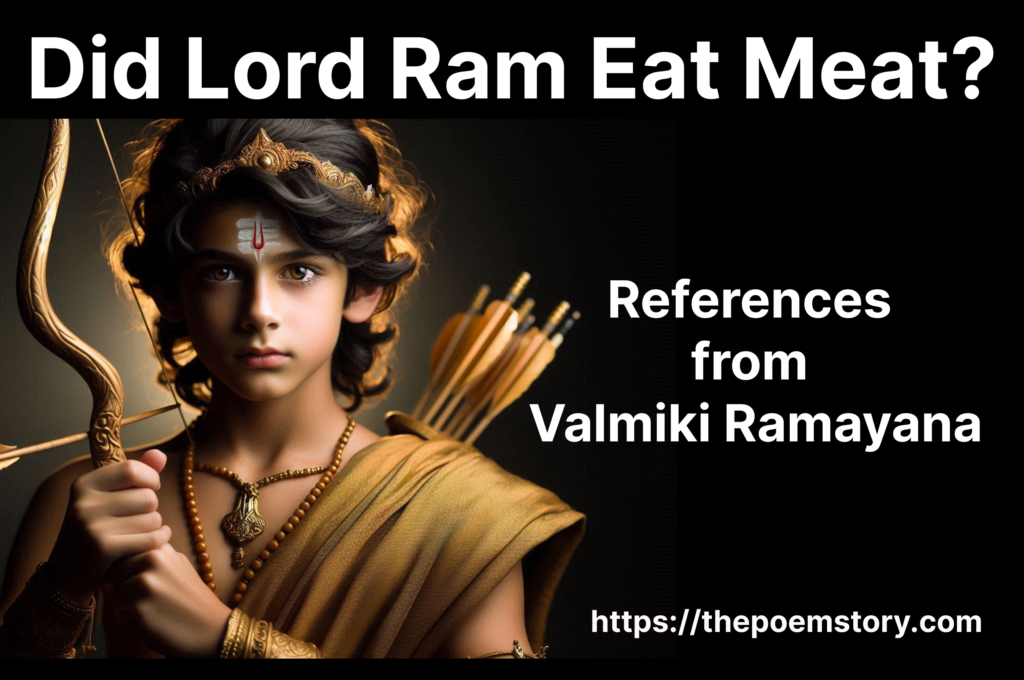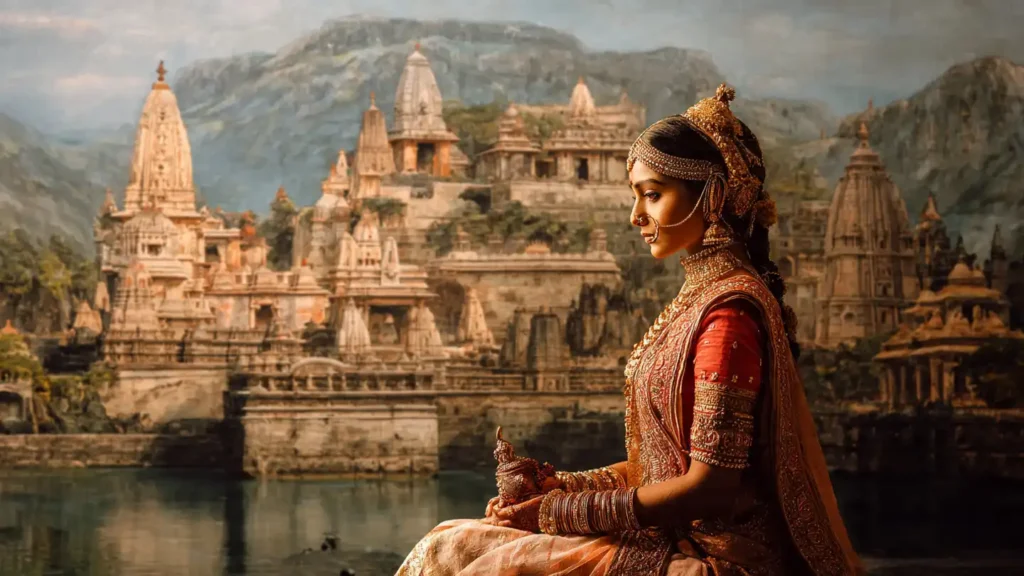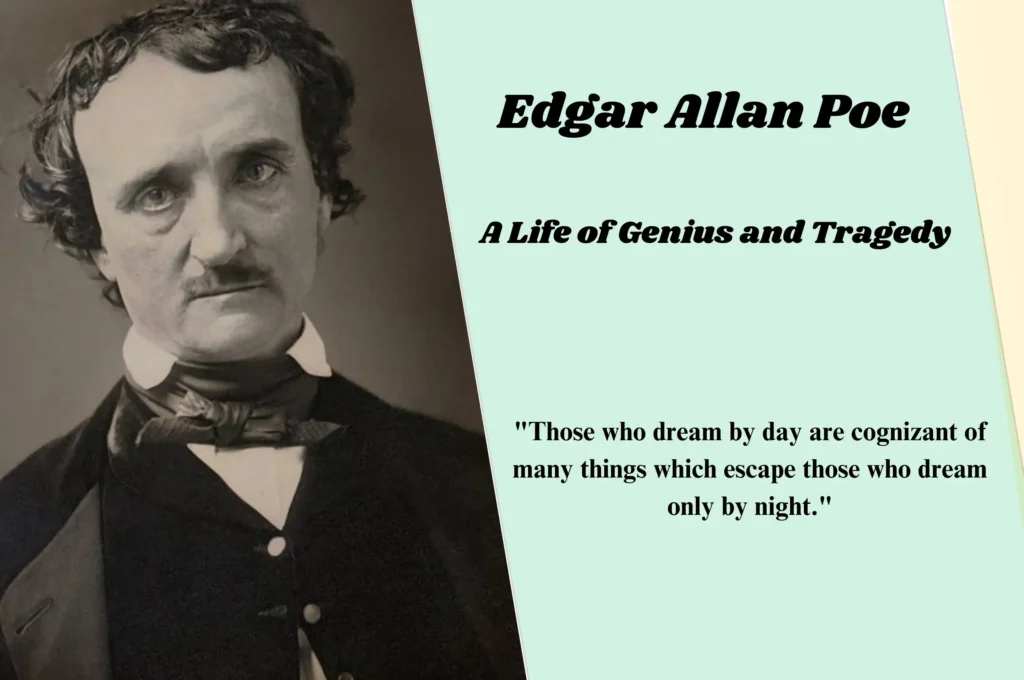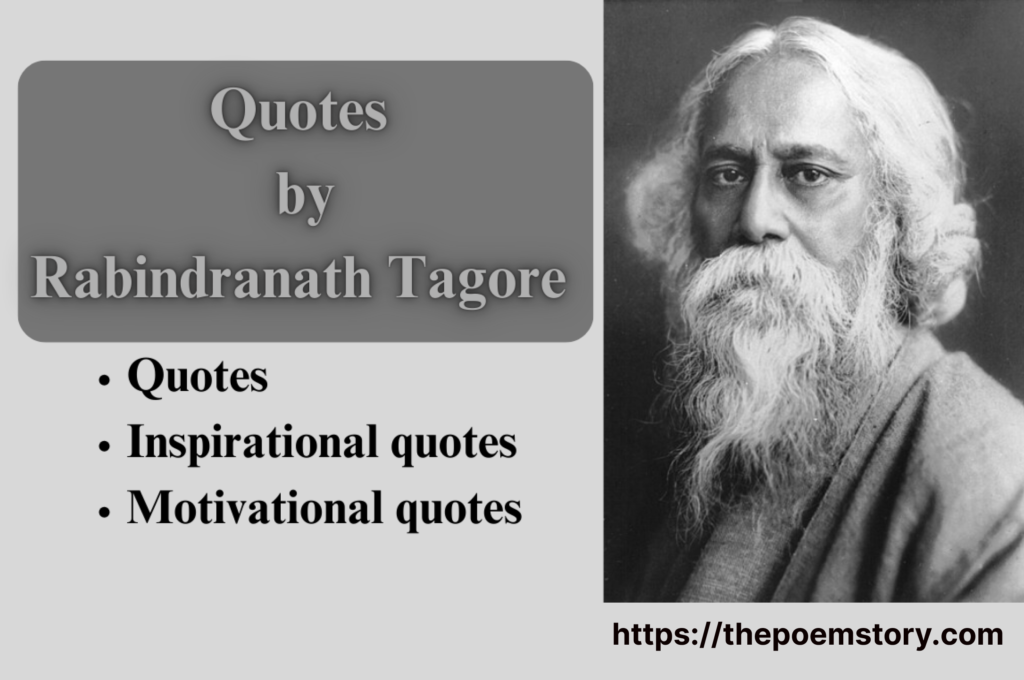Did Lord Ram Eat Meat? In this post we will look into the evidence from Valmiki Ramayana and try to find if lord Ram consumed meat or non-vegetarian food. We will take references from Valmiki Ramayana and see the translations of the Shloka. It is recommended that you read this post with an open mind.
Before you go through this article, let me make is clear that I do not worship Ram for his eating habits. It is for good deeds and morality that he holds. Before you make an opinion, please read Valmiki Ramayana as I believe that is the most authentic source of knowledge about Lord Rama. Jai Shri Ram!
We will keep bringing you such articles on our website: https://thepoemstory.com

Table of Contents
The Description of Rama as per Maricha
The following shloka is spoken by King Dashrath, expressing that Rama was only a 12-year-old boy when Sage Vishwamitra took him to safeguard the Yagna. It was during this event that Sri Ram faced and struck Maricha, severely wounding him.
बालो ह्यकृतविद्यश्च न च वेत्ति बलाबलम्।
~ Valmiki Ramayana, Balkand, Sarg 20, Shloka 7
न चास्त्रबलसंयुक्तो न च युद्धविशारद:।।1.20.7।।
न चासौ रक्षसां योग्य: कूटयुद्धा हि ते ध्रुवम् ।
हि indeed, बाल: a child, अकृतविद्यश्च is not learned in the science of warfare, बलाबलम् strengths and weaknesses, न वेत्ति does not know, अस्त्रबलसंयुक्त:च न has not acquired the strength of weapons, युद्धविशारद: च न not proficient in warfare, असौ he, रक्षसाम् of rakshasas, योग्य:न is not qualified, ते those rakshasas, ध्रुवम् certainly, कूटयुद्धा: हि are deceitful in battle.
Rama is still a young boy, inexperienced in the art of warfare. He is unaware of the strengths and weaknesses of enemies and has not yet mastered the use of weapons or gained proficiency in combat. You are well aware that rakshasas are treacherous in battle, making him unfit to confront them successfully.
In Aranya Kanda, Marich narrates the Valor of Bhagwan Sri Ram to Ravana. When he is asked to disguise as golden Deer.
अजातव्यञ्जनश्रीमान्पद्मपत्रनिभेक्षणः।
– Valmiki Ramayana, Aranya Kand, Sarg 38, Shloka 14
एकवस्त्रधरो धन्वी शिखी कनकमालया।।3.38.14।।
शोभयन् दण्डकारण्यं दीप्तेन स्वेन तेजसा।
अदृश्यत ततो रामो बालचन्द्र इवोदितः।।3.38.15।।
Thereafter, the handsome Rama, with eyes like lotus petals, a youthful face untouched by a beard, dressed in a single garment, and with knotted hair atop his head, carrying a bow and adorned with a golden chain, radiated a brilliance of his own. His presence graced the Dandaka forest, resembling the beauty of a newly risen young moon.
Maricha goes on saying to Ravana about Lord Ram:
रामो विग्रहवान् धर्मस्साधुस्सत्यपराक्रमः।
– Valmiki Ramayana, Aranya Kand, Sarg 37, Shloka 13
राजा सर्वस्य लोकस्य देवानां मघवानिव।।3.37.13।।
Rama is the embodiment of dharma, embodying righteousness and virtue. He is devoted to piety, with truth as his greatest strength. Just as Indra reigns over the gods, Rama is the sovereign of all the worlds
Rama, at the time of his encounter with Maricha, was a 12-year-old boy. He was dressed simply, wearing just a single cloth wrapped around his body, as he was living the life of a brahmachari. Additionally, he had a golden necklace or garland and, most notably, a shikha (a tuft of hair).
This encounter with Maricha took place a few months to less than a year before the Sita Kalyanam (the marriage of Rama and Sita). According to the Valmiki Ramayana (as per the authentic narrative), Rama was married to Sita when he was 13 years old, while Sita was 6. Your personal interpretations, opinions, or visualizations might differ, but for the purpose of this video, we will adhere strictly to the Valmiki Ramayana.
Now, let’s break down Maricha’s words into two key aspects:
- Kanakam Malaya – This phrase refers to the physical appearance of Shri Rama. Descriptions of his external appearance are factual but situational, as appearances naturally change over time. Therefore, such descriptions cannot be consistently verified throughout the Valmiki Ramayana.
- Rama as the Embodiment of Dharma – This is the enduring truth of the Ramayana. Unlike his appearance, Rama’s unwavering adherence to Dharma (righteousness) is a recurring theme. His commitment to truth and virtue is evident in multiple instances, especially during times of great adversity.
The Ramayana is valued more for its universal truths than for its factual details. Let’s keep this perspective in mind as we continue exploring this timeless epic.
Did Lord Ram Eat Meat?
Now, let’s get straight to the point: Did Lord Ram Eat Meat? This question often sparks debate, with two distinct perspectives.
One side references verse indicating that Sri Rama took a vow to live like an ascetic, abstaining from meat and other comforts. The other side points to verses that describe him hunting animals and consuming meat. So, what is the truth? Let’s explore this question objectively over the next few minutes without bias or preconceptions.
First and foremost, we should avoid passing hasty judgments about sections of the Ramayana simply because we find them uncomfortable or disagree with them. Such an approach is irrational and unproductive. More importantly, this is not a matter of forming opposing camps—”you are right” versus “I am right.” The goal is to seek the truth, not to satisfy or hurt anyone’s ego. Personally, I am indifferent to opinions driven by ego; my only concern is the pursuit of truth.
Before delving deeper into the Ramayana, I want to make one crucial point about dietary choices: whether someone is vegetarian or non-vegetarian, it should not be a cause for division or superiority. If I am a vegetarian, I do not look down on those who consume meat. Conversely, if I eat meat, I do not mock those who strictly adhere to a vegetarian lifestyle. This is a matter of personal choice, not moral supremacy.
Vegetarian and Non-Vegetarian Food as per scriptures
Now, regarding what the Vedas and Upanishads say about vegetarianism and non-vegetarianism, let’s set that aside for a moment. The fundamental point about life is this: life originates in three forms—through eggs, through the womb (from parents), and through plants. Life exists in all these forms. Therefore, being vegetarian does not necessarily make one less violent, as plants are living beings too. This understanding aligns with both scientific consensus and the wisdom of Vedic teachings.
Thus, no one holds a higher moral ground to preach superiority based on dietary choices. Additionally, our understanding of ahimsa (non-violence) has often been misconstrued, especially in the context of Gandhian philosophy. True ahimsa is far more nuanced than the simplistic notion of non-violence commonly taught.
With this foundation in mind, let us proceed to analyze Sri Rama’s actions as described in the Valmiki Ramayana with clarity and sincerity, guided by truth rather than preconceived notions.
No one stands on a moral pedestal to preach to others. Briefly addressing our understanding of ahimsa (non-violence), unfortunately, it is often taught incorrectly, particularly in the context of Gandhian philosophy, which equates ahimsa solely with complete non-violence. This is a misunderstanding.
According to the Vedic corpus and the principles of dharma, ahimsa means minimizing violence as much as possible—not a rigid, absolutist definition of non-violence. To grasp the true meaning of ahimsa, one must study texts like the Mahabharata, where it is defined in a more practical and balanced way. However, that is a discussion for another time.
For now, whether one is a vegetarian or a non-vegetarian, it is important to acknowledge a simple truth: life is taken to provide food, regardless of the form it comes in. This understanding should foster humility rather than superiority in dietary debates.
With this perspective, let us begin to explore the culture and dietary practices described in Sri Ramayana, specifically regarding meat consumption and the eating habits of that time.
Reference 1 from Valmiki Ramayana ~ Did Lord Ram Eat Meat?
In this reference Lord Rama is exiled to the forest and he meets Nishad Raj Guha. Nishad Raj Guha helps them cross the river, Ganga. At the crossing, Sita prays to the goddess Ganga, vowing that upon his return to Ayodhya after 14 years, she will offer a thousand pots of sura (a consecrated drink) and mamsa (meat cooked with rice) as a token of gratitude. The mention of mamsabhutodana aligns with references to a dish similar to what we recognize today as biryani. Ancient texts, including the Upanishads, Ramayana, and Mahabharata, describe mamsa as rice, ghee, and meat cooked together with spices — an early form of the dish.
सुराघटसहस्रेण मांसभूतौदनेन च।
– Valmiki Ramayana, Ayodhya Kand, Sarg 52, Shloka 89
यक्ष्ये त्वां प्रयता देवि पुरीं पुनरुपागता।।2.52.89।।
देवि O Devi, पुनः again, पुरीम् Ayodhya, उपागता having reached, प्रयता purified by austerities, सुराघटसहस्रेण with a thousand pots of nectar, मांसभूतौदनेन च meat with cooked rice, यक्ष्ये offer you and worship you.
O Devi after my return to Ayodhya purified by my austerities, I shall worship you by offering a thousand pots of nectar and food in the form of meat.
Finally, it is essential to address a common mistranslation. The term mamsa does not refer to fruit pulp, as some suggest. This interpretation is inaccurate; mamsa consistently denotes meat across ancient scriptures, further affirming that meat consumption was a recognized part of the diet and culture during the time of the Ramayana.
Reference 2 from Valmiki Ramayana ~ Did Lord Ram Eat Meat?
After crossing the River Ganga, Rama and Lakshmana paused along its banks and hunted four different types of deer or antelope. The word hatwa in the first line explicitly means “to kill.” However, in the third line, another significant term appears — medhyam. I won’t reveal its meaning just yet, but it is essential to note this term carefully. It consistently appears whenever Rama hunts an animal for food. While hatwa refers to the act of killing, medhyam holds a deeper context.
तौ तत्र हत्वा चतुरो महामृगान्
– Valmiki Ramayana, Ayodhya Kand, Sarg 52, Shloka 102
वराहमृश्यं पृषतं महारुरुम्।
आदाय मेध्यं त्वरितं बुभुक्षितौ
वासाय काले ययतुर्वनस्पतिम्।।2.52.102।।
बुभुक्षितौ famished, तौ they, तत्र there, वराहम् a boar, ऋश्यम् a whitefooted male antelope, पृषतम् spotted deer, महारुरुम् a great deer with black stripes, चतुरः four, मृगान् animals, हत्वा killed, मेध्यम् pure meat, त्वरितम् quickly, आदाय partaking as food, काले in the evening, वासाय for rest, वनस्पतिम् under a tree, ययतुः reached.
Famished, they (Rama and Lakshmana) killed a boar, a rishya (whitefooted male antelope), a spotted deer and a great deer with black stripes. They partook the meat and reached a tree by evening where they rested for the night.
As they journeyed from the Ganga toward the Yamuna, Rama and Lakshmana once again hunted a deer. The term hatwa is used, indicating the act of killing, and yet again, the word medhyam appears. What does medhyam mean? Let’s keep exploring.
क्रोशमात्रं ततो गत्वा भ्रातरौ रामलक्ष्मणौ।
– Valmiki Ramayana, Ayodhya Kand, Sarg 55, Shloka 33
बहून्मेध्यान्मृगान्हत्वा चेरतुर्यमुनावने।।2.55.33।।
तत: then, भ्रातरौ the two brothers, रामलक्ष्मणौ Rama and Lakshmana, क्रोशमात्रम् a krosa, गत्वा having gone, मेध्यान् suitable for sacrifice (pure), बहून् many, मृगान् deer, हत्वा having slain, यमुनावने in the forest on the bank of Yamuna, चेरतु: ate.
After walking a krosa (Kosha in Distance) into the forest on the bank of Yamuna, the two brothers killed many deer suitable for sacrifice and ate them.
Later, when they reach Chitrakoot, there is a scene where Rama offers a piece of roasted deer meat, freshly cooked over fire. In this instance, Rama describes the meat as medhyam and swadu — the latter meaning “tasty” or “flavorful” in Hindi. But what exactly is medhyam? We are still unraveling its significance.
When Rama, Sita, and Lakshmana build their hut in the forest, there is a ritual to sanctify the dwelling. Rama asks Lakshmana to gather the necessary items, and Lakshmana hunts a black antelope, roasting it over the fire. The term medhyam is referenced again, connected to a sacred offering into the fire as part of a Vedic ritual (aghnihotra). In Sanskrit, medhyam refers to a sacrificial offering rather than casual consumption.
वन्यैर्माल्यैः फलैर्मूलैः पक्वैर्मांसैर्यथाविधि।
– Valmiki Ramayana, Ayodhya Kand, Sarg 56, Shloka 34
अद्भिर्जपैश्च वेदोक्तैर्दर्भैश्च ससमित्कुशैः।।2.56.34।।
तौ तर्पयित्वा भूतानि राघवौ सह सीतया।
तदा विविशतु श्शालां सुशुभां शुभलक्षणौ।।2.56.35।।
शुभलक्षणौ bestowed with auspicious qualities, राघवौ Rama and Lakshmana, सह सीतया accompanied by Sita, वन्यै: माल्यै: with garlands of forest flowers, फलै: with fruits, मूलै: with roots, पक्वै: with wellcooked, मांसै: with venison, अद्भिः with water, वेदोक्तै: as expounded in the Vedas, जपैश्च with muttering of prayers, दर्भैश्च with darbha grass, सुसमित्कुशै: with faggots and kusa grass, भूतानि all beings, तर्पयित्वा after propitiating, तदा then, शुभाम् auspicious, शालाम् hut, विविशतुः entered.
Bestowed with auspicious qualities, Rama and Lakshmana along with Sita propitiated those celestial beings with garlands of forest flowers, fruits and roots, wellcooked venison, water, muttering of prayers as expounded in the Vedas, faggots and kusa grass and entered that auspicious hermitage.
One detailed narrative describes Sri Rama and Lakshmana preparing a black antelope as part of a ritual in Chitrakuta. The translation notes that they pleased the devas by offering forest flowers, fruits, roots, water, and medam, indicating cooked meat as a sacred offering. Unlike the luxurious descriptions of feasts for Ravana or Bharata’s hospitality by Guha and Bharadwaja, where meat consumption symbolizes royal grandeur, Sri Rama’s consumption of meat was always tied to dharma and ritual.
In all instances where Rama consumes meat, medhyam is associated with the context. It emphasizes that he partook of meat not for personal pleasure but as part of the religious and cultural practices of the time. This distinction is essential to understanding the role of food and rituals in Ramayana.
In ancient Vedic rituals, meat played a significant role, a practice now completely extinct in today’s Vedic ceremonies. However, references to meat as part of sacred rituals are evident in texts like the Ramayana. For instance, the term Krishna mṛugam refers to a black deer or antelope, and hatvā means “to kill,” while medhyam denotes something fit for ritualistic offering. Unlike descriptions of royal feasts—where meat is a luxury or comfort food—the references to meat consumption by Bhagavan Sri Rama in the Ramayana consistently use ritualistic terms, emphasizing duty rather than pleasure.
Meat Eating in Valmiki Ramayana
Reference 1
This episode occurs when Bharata learns that Bhagavan Sri Ram has been exiled. Determined to bring him back to Ayodhya, Bharata sets out on the same path that Sri Ram and Lakshmana took. Along the journey in search of Bhagwan Sri Ram, he encountered Guha, the king of Nishaad’s and a fisherman by trade. Guha welcomed Bharata with the best feast he could offer. As per Valmiki Ramayana, Guha presented fish, meat, honey, and various other offerings. The detailed description mentions roots, fruits, fresh meat, dried meat, and other forest produce served to Bharata.
इत्युक्त्वोपायनं गृह्य मत्स्यमांसमधूनि च।
– Valmiki Ramayana, Ayodhya Kand, Sarg 84, Shloka 10
अभिचक्राम भरतं निषादाधिपतिर्गुहः।।2.84.10।।
निषादाधिपतिः गुहः overlord of the nishadas, Guha, इति thus, उक्त्वा having spoken, मत्स्यमांसमधूनि fish, meat and wine, उपायनम् as gifts, गृह्य holding, भरतम् to Bharata, अभिचक्राम approached.
Having said this, Guha, the king of the Nishadas, approached Bharata with offerings of fish, meat, and wine.
अस्ति मूलं फलञ्चैव निषादैस्समुपाहृतम्।
– Valmiki Ramayana, Ayodhya Kand, Sarg 84, Shloka 17
आर्द्रं च मांसं शुष्कं च वन्यं चोच्चावचं महत्।।2.84.17।।
निषादैः by nishadas, समुपाहृतम् have been brought, मूलम् root, फलं चैव fruits also, वन्यम् the forest produce, आर्द्रम् fresh, शुष्कं च dried, उच्चावचम् of great variety, महत् best, मांसं च अस्ति meat are here.
Here are roots, fruits and a great variety of forest produce, fresh and dried meat brought by the nishadas.
There are significant points to unpack from this narrative. First, in both the hospitality extended by Sage Bharadwaja and Guha, non-vegetarian food prominently features as part of Bharata’s royal meals. This observation is not an interpretation or extrapolation but a direct reading from the text of Valmiki Ramayana.
Another interesting takeaway from Guha’s feast is the inclusion of dried meat. In modern Indian cuisine, dried meat has almost disappeared, except for certain varieties of dry fish. However, it is evident that dried meat was part of the diet in those times, demonstrating the richness and diversity of ancient culinary practices.
A critical aspect often overlooked is the contrasting relationship dynamics between Guha and Sri Rama versus Guha and Bharata. When Sri Rama first meets Guha, they share an emotional embrace. Guha, as a close friend of Rama, provides heartfelt companionship. He is not depicted as a subordinate or devotee but as a dear sakha (friend). Rama’s embrace of Guha, a fisherman and hunter, underscores his humility and inclusiveness, breaking caste-based discrimination. This powerful message of equality and friendship is a profound teaching of Ramayana. Conversely, Bharata does not initially know Guha and requires a minister to introduce him. With Guha’s help, Sri Rama, Sita, and Lakshmana cross the Ganga River.
Reference 2
While Bharata reaches the Ashram of Bharadwaj Rishi. Bharadwaj Maharishi welcomes Bharata and his army with grand hospitality, offering a royal feast. The hospitality includes garlands made from fresh flowers, wines, various drinks, and an assortment of meats. According to Valmiki Ramayana, the meats served at this royal feast include peacock, rooster, and other types of meat.
आजैश्चापि च वाराहैर्निष्ठानवरस़ञ्चयैः।
– Valmiki Ramayana, Ayodhya Kand, Sarg 91, Shloka 68 and 69
फलनिर्यूह संसिद्दैस्सूपैर्गन्ध रसान्वितैः।।2.91.68।।
पुष्पध्वजवतीः पूर्णाश्शुक्लस्यान्नस्य चाभितः।
ददृशुर्विस्मितास्तत्रनरा लौहीस्सहस्रशः।।2.91.69।।
तत्र there, नराः men, आजैश्चापि with mutton, वाराहैश्च pork, निष्ठानवरसञ्चयैः with choicest condiments, फलनिर्यूह संसिद्दैः with various fruit juices, गन्धरसान्वितैः with fragrant and tasteful, सूपैः with soups, पूर्णाः filled with, शुक्लस्य white, अन्नस्य rice, लौहीः best of iron containers, अभितः on all sides, विस्मिताः were amazed, ददृशुः beheld.
The soldiers gazed in wonder at thousands of iron containers adorned with flags and flowers, each brimming with white rice, mutton, pork, exquisite condiments, fruit juice, and fragrant, flavorful soup.
वाप्यो मैरेयपूर्णाश्च मृष्टमांसचयैर्वृताः।
– Valmiki Ramayana, Ayodhya Kand, Sarg 91, Shloka 71
प्रतप्तपिठरैश्चापि मार्गमायूरकौक्कुटैः।।2.91.71।।
वाप्यः wells, मैरेयपूर्णाश्च filled with datepalm liquor, प्रतप्तपिठरैः with hot pots (filled with cooked meat), मार्गमायूरकौक्कुटैः meat of peacock, chicken and deer, मृष्णमांसचयैः meat of other animals, वृताः surrounded by.
The wells were filled with date palm liquor and surrounded by pots containing well-cooked meat of peacocks, chicken, and various other animals.
विचित्राणि च माल्यानि पादपप्रच्युतानि च।
– Valmiki Ramayana, Ayodhya Kand, Sarg 91, Shloka 21
सुरादीनि च पेयानि मांसानि विविधानि च।।2.91.21।।
पादपप्रच्युतानि those dropped from trees, विचित्राणि many colored, माल्यानि च flower garlands, सुरादीनि wines and others, पेयानि drinks, विविधानि of different kinds, मांसानि च meat be furnished.
Let her furnish me with many-colored garlands of fresh flowers from trees, wines and other drinks and meat of different kinds.
It is important to note that this feast reflects the hospitality extended by Bharadwaj Maharishi to Bharata and his army—it does not represent the personal diet of the sage himself. The details about the feast highlight the grandeur and respect shown to the visiting prince and his followers.
Counter-Arguments on Ram Not Eating Meat
Attempts to retrofit current customs onto ancient practices often lead to misunderstandings. One common counterargument is based on the episode where Sri Rama bids farewell to his mother before his exile. The phrase often translated as abstaining from meat uses the term amish, typically interpreted as flesh or non-vegetarian food. However, a deeper contextual reading reveals that amish also signifies luxurious or indulgent consumption. Sri Rama’s declaration to live like a sage implies renouncing not only meat but all luxuries—a clear indication that meat was previously part of his diet but would now be given up in its luxurious form.
चतुर्दश हि वर्षाणि वत्स्यामि विजने वने।
– Valmiki Ramayana, Ayodhya Kand, Sarg 20, Shloka 29
मधुमूलफलैर्जीवन्हित्वा मुनिवदामिषम्।।2.20.29।।
अमिषम् all meat, हित्वा abstaining, मुनिवत् like a hermit, मधुमूलफलैः honey, fruits and roots, जीवन् while living on, चतुर्दश fourteen, वर्षाणि years, विजने in a solitary, वने in the forest, वत्स्यामि am to dwell.
Abstaining from eating meat like hermits and living on honey, fruits and roots, I am to live in the solitary forest for fourteen years.
This is the general translation commonly found online. The word “Amish” is often translated as “meat” or “flesh.” However, a deeper exploration reveals a more nuanced meaning.
If you refer to a Samskritam dictionary for the term “Amish”, it indeed includes “flesh” or “non-vegetarian food” as a meaning, but it also expands on the idea, contextualizing it as something associated with pleasure, comfort, desire, or luxury.

Now, when we analyze the shlokam where Shri Ram speaks about his life in exile, he mentions living like a sage—forsaking all forms of luxury, including the consumption of meat. The emphasis here is on giving up luxury. This implies that meat consumption, considered a luxury at the time, was part of his regular diet.
Meat Consumption In Sundar Kanda
Moving further, when Hanuman, in search of Mata Sita, entered Ravana’s palace, he came across a royal feast prepared for Ravana. This feast is vividly described in the Ramayana, detailing the variety of foods, especially the meats, that were served. Hanuman observed intoxicating drinks alongside an assortment of meats, including deer, buffalo, wild boar, and other delicacies, portioned and placed in Ravana’s palace.
Hanuman also noted meats of pigs, goats, porcupines, deer, and peacocks that were preserved and marinated in a mixture of salts, spices, and curds, all meticulously prepared for Ravana.
मृगाणां महिषाणां च वराहाणां च भागशः।।5.11.11।।
– Valmiki Ramayana, Sundarkand, Sarg 11, Shlok 11
तत्र न्यस्तानि मांसानि पानभूमौ ददर्श सः।
सः he, तत्र there, पानभूमौ at the drinking hall, भागशः in portions, न्यस्तानि placed, मृगाणाम् on the deer, महिषाणां च buffaloes, वराहाणां च pigs, मांसानि meat, ददर्श saw.
There at the drinking hall the meat of deer, buffaloes and boars portioned and placed.
रौक्मेषु च विशालेषु भाजनेष्वर्धभक्षितान्।।5.11.12।।
– Shlokas from Sundarkand, Banquet Hall of Ravana
ददर्श हरिशार्दूलो मयूरान् कुक्कुटांस्तथा।
हरिशार्दूलः tiger among vanaras, रौक्मेषु in golden, विशालेषु in large ones, भाजनेषु vessels, अर्धभक्षितान् half eaten, मयूरान् peacocks, तथा so also, कुक्कुटान् chicken, ददर्श saw.
The tiger among vanaras also saw there meat of peacocks and chicken placed in large golden vessels, some half eaten.
—
वराहवार्ध्राणसकान् दधिसौवर्चलायुतान्।।5.11.13।।
शल्यान् मृगमयूरांश्च हनुमानन्ववैक्षत।
दधिसौवर्चलायुतान् marinated with yoghurt and special salt, वराहवार्ध्राणसकान् meat of pigs and jungle fowls, हनुमान् Hanuman, अन्ववैक्षत observed, शल्यान् bones, मृगमयूरांश्च deer and peacocks.
Hanuman saw the meat of pigs and jungle fowls, deer, peacocks and bones marinated with yoghurt and special kinds of salt.
—
क्रकरान्विविधान् सिद्धांश्चकोरानर्धभक्षितान्।।5.11.14।।
महिषानेकशल्यांश्च छागांश्च कृतनिष्ठितान्।
लेह्यानुच्चावचान्पेयान् भोज्यानि विविधानि च।।5.11.15।।
विविधान् several types, सिद्धान् cooked, क्रकरान् fowls, अर्धभक्षितान् half eaten, चकोरान् ruddy geese, महिषान् buffaloes, एकशल्यांश्च fishes, छागांश्च goats, उच्चवचान् all sorts of them, लेह्यान् varieties of food that can be licked, पेयान् drinks, विविधानि of many kinds, भोज्यानि eatables.
He saw several kinds of (nonvegetarian) food like cooked meat of fowls, ruddy geese, buffaloes, goats, fishes as well as food for licking. (Food is of four kinds 1) भक्ष्य which can be chewed 2) भोज्य ordinary solid, semisolid food which can be consumed 3) लेह्य food for licking 4) चोष्य liquid food (which can be sipped)).
—
तथाऽऽम्ललवणोत्तंसैर्विविधैरागषाडबैः।
हारनूपुरकेयूरैरपविद्धैर्महाधनैः।।5.11.16।।
पानभाजनविक्षिप्तैः फलैश्च विविधैरपि।
कृतपुष्पोपहारा भूरधिकं पुष्यति श्रियम्।।5.11.17।।
तथा so also, आम्ललवणोत्तंसैः seasoned with sour and salty ingredients, विविधैः with many types, रागषाडबैः with syrups, अपविद्धै: with discarded, महाधनैः with heavy, हारनूपुरकेयूरैः with chains, anklets, shoulder straps, पानभाजनविक्षिप्तै: with those drinks spilt from the glasses, विविधैः with many, फलैश्च fruits, कृतपुष्पोपहारा with the offerings flowers of, भूः the earth, अधिकम् greatly, श्रियम् rich, पुष्यति looked splendid.
The banquet hall looked splendid with food seasoned with salt and sour ingredients. There was ragashadavas (syrup made with grapes, pomegranates, different juices like half ripe mangoes and seasoned with ginger cardomom, butter etc). Heavy chains, anklets and shouldersstraps were thrown aside. (The people relaxed while eating and drinking and discarded heavy ornaments). Many glasses were found scattered or drinks spilt on the floor after use.Many fruits and flowers were kept.
The nuance here is important: the meat described in Ravana’s feast, as well as the meat and fish offered to Bharat by Guha in another instance, is presented as part of a luxurious royal banquet. The narration highlights the extravagance and opulence of such meals.
In contrast, whenever Bhagwan Shri Ram consumed meat, it was described as medhyan—a simple preparation of roasted meat cooked over a fire. It was often offered as prasadam during specific rituals, emphasizing its simplicity and spiritual significance.
The Sundarakanda provides the most elaborate details about food in the entire Ramayana. The grand royal feast arranged for Ravana included meats of peacock, rooster, pigs, goats, porcupine, fish, buffalo, and other animals. It also featured various grains, plant-based foods, and an array of natural and synthetic liquors made from honey, roots, tree bark, and herbs.
This extravagant spread of food and drink, showcasing both luxury and indulgence, was all prepared for one person—Ravana.
Conclusion – Did Lord Ram Eat Meat?
Let’s circle back to where I started—facts and truth. It’s okay if we sometimes get mixed up with the facts, but we must be absolutely clear about the truth.
The truth is that Bhagwan Shri Ram is worshipped for his divine qualities, his unwavering commitment to Dharma, and his noble virtues. Whether he was vegetarian or non-vegetarian has no bearing on why he is revered. As I’ve already mentioned, it is evident that Shri Ram consumed meat during his time in the forest, and this is an unchangeable truth.
However, this does not mean that offering meat as prasadam to Bhagwan Shri Ram is acceptable today. Due to present-day customs and traditions, it is forbidden—and rightly so. This cultural practice must be respected.
If you are vegetarian, continue being one; if you are non-vegetarian, that’s your choice. But my only point is this: do not impose your personal beliefs or opinions onto Shri Ram. Instead of hating me or this video, I encourage you to read Valmiki Ramayanam, the most reliable and authentic source for understanding the truth and facts about Shri Ram’s life.
If you’re interested, you can also explore other versions like Ram Charit Manas or Kamba Ramayanam. That’s entirely up to you. But remember, every word in Valmiki Ramayanam carries profound meaning, and to truly understand it, we need to question and explore it deeply.
You can read the Shlokas and Translations on: https://www.valmiki.iitk.ac.in/
















